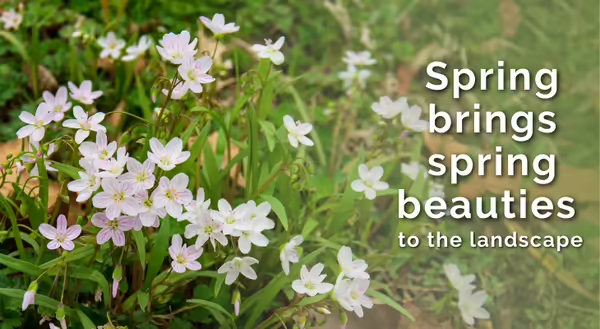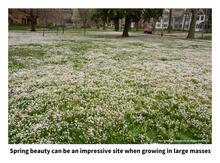
Have you ever noticed small white flowers dotting the landscape this time of year? Chances are they’re spring beauties (Claytonia virginica). While they may not be the first wildflowers to bloom, spring beauties are one of our earlier blooming wildflowers and a sure sign that spring has arrived. Individually, these wildflowers may not be the most impressive plants out there, but when growing in large masses, they are a sight to behold.
Spring beauty can be found throughout Illinois and the Eastern United States in various habitats, including woodlands, meadows, yards, and parks. Because they can tolerate degraded habitats better than most of our wildflowers, they are still relatively common.
These plants grow from small (about the size of a peanut) potato-like tubers (corm). In spring, they will produce grass-like foliage that will get about six inches tall. If you’ve ever seen these plants growing in lawns, you know that the foliage blends in well with turfgrass. Since these plants are ephemeral, the foliage will die back and disappear in late spring as the plants go dormant.
We aren’t growing them for their leaves but their flowers. Spring beauty begins blooming in mid-to-late spring (this year in Jacksonville, they started blooming in early April) and will last for 1-2 months. Plants will produce flower stalks (in this case, racemes) with clusters of star-like flowers. The small flowers appear white from a distance, but if you look closely, you will see the petals have pink stripes on them. The flowers will open on sunny days and will close at night or when it is cloudy. In addition to their visual appeal, they also serve as pollen and nectar sources for pollinators.
Different flower colors
While spring beauty flowers are typically white, you may have noticed that they can vary from white to pink to almost crimson. These different flower colors don’t have anything to do with growing or soil conditions. (For example, bigleaf hydrangea flower colors change depending on soil pH.) Instead, research has shown that it has to do with natural selection.
The color of spring beauty flowers is affected by three different chemicals. One (cyanidin) causes flowers to be pink/crimson. When two other chemicals (quercetin and kaempferol) are present, it causes the flowers to become lighter in color and nearly white in high enough concentrations. So how does natural selection play into what color flowers are produced?
- Darker pink/crimson flowers are more attractive to bees, one of these plants’ main pollinators. Since these flowers are more attractive, pollinators visit them more. Since they are visited more, they are better pollinated, and they end up producing more seeds.
- The chemicals that cause the flowers to turn white also help protect plants from attack by herbivores. Research has shown that slugs feed on plants with darker (pink/crimson) flowers more than plants with white flowers. The drawback is that pollinators find these flowers less attractive, so the plants produce fewer seeds. But, while pink flowers may be more attractive to pollinators, if something eats you before you can produce seed, that doesn’t do you much good.
- It’s also been found that in areas where there are lots of other plants that produce white flowers at the same time as spring beauty, spring beauty flowers tend to be pinker. Since pollinators find those flowers (pink) more attractive, those are the plants that get pollinated more and produce seeds, leading them to eventually become the more common flower color.
How can I grow my own?
If you’ve ever wanted some spring beauty in your landscape, they can be grown from corms or seeds. Growing from corms is going to be the quickest and easiest. These are planted about three inches deep. Corms can be obtained from online nurseries and possibly in local plant sales. If you decide to dig plants from the wild, make sure you have permission from the landowner and don’t overharvest.
These plants can also be grown from seed, but you’ll need to have some patience. Seeds can also be purchased or collected (again, make sure you have permission). If you are collecting seeds, gather the stems once the seed capsules turn brown. Once the seeds are ready, the capsules will split open, and the seeds will be ejected up to four feet away. Because of this, it is probably a good idea to put the stems in a bag or box to contain the seeds.
Once you have your seeds, you’ll need to plant them ASAP since they quickly lose their viability if they dry out. Here is where your patience comes in. The seeds of spring beauty need to go through not one but two dormancies (double dormancy). The seeds need to be exposed to warm moist conditions (summer) followed by a cold, moist period (winter). Therefore, your seeds won’t begin to germinate until the year after they are planted! Like many perennial plants, they will put a lot of energy into producing a root system the first year. So, flowering likely won’t happen until the year after, two-three years after sowing seed.
Spring beauty and the ant
In addition to being ejected from their seed capsules, seeds of spring beauty are also moved around by ants (this type of seed dispersal is called myrmecochory). The seeds of spring beauty and other early-blooming wildflowers such as bloodroot, trout lily, and Dutchman’s breeches contain elaiosomes. What is an elaiosome you ask? They are fleshy structures that can be found on some seeds that are full of fats.
Ants collect these seeds and bring them back to their nests to feed on the elaiosomes. By doing this, they help disperse the seeds away from the parent plant. Once the ants have eaten the elaiosome, they will dispose of the seed in an abandoned gallery in their nests or a trash pile close to their nests. Doing so provides the seeds with an area that has lots of nutrients that will aid their growth.
Good Growing Fact of the Week: The corms of spring beauty are edible, which has given rise to another name for this plant, the fairy spud. After cooking, they have been described as having a texture similar to potatoes and tasting like boiled chestnuts.
Want to get notified when new Good Growing posts are available? SIGN ME UP!
Sources:
“Claytonia virginica - Plant Finder.” Accessed April 12, 2021. https://www.missouribotanicalgarden.org/PlantFinder/PlantFinderDetails.aspx?kempercode=j800.
Frey, Frank M. “Opposing Natural Selection from Herbivores and Pathogens May Maintain Floral-Color Variation in Claytonia Virginica (Portulacaceae).” Evolution 58, no. 11 (November 2004): 2426–37. https://doi.org/10.1111/j.0014-3820.2004.tb00872.x.
Lisci, Marcello, Massimo Bianchini, and Ettore Pacini. “Structure and Function of the Elaiosome in Some Angiosperm Species.” Flora 191, no. 2 (1996): 131–41. https://doi.org/10.1016/s0367-2530(17)30704-1.
Rico-Gray, Victor, and Paulo S. Oliveira. The Ecology and Evolution of Ant-Plant Interactions. Chicago, IL: University of Chicago Press, 2007. https://chicago.universitypressscholarship.com/view/10.7208/chicago/9780226713540.001.0001/upso-9780226713472.



